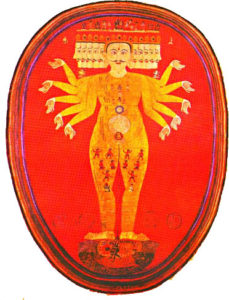 Ravana appears in the Ramayana as the demon-king of Lanka and the principal antagonist of Rama. In all versions of the Ramayana, he is vanquished and killed by Rama in a ferocious battle where both are compelled to call upon all the resources at their command, including the most awesome weapons. Thus is Sita, who had been abducted by Ravana, restored to her husband. If Rama stands forth as a shining example of the virtuous ruler, Ravana is, in the common imagination, the very sign of evil. In Hindi, for instance, a man who behaves wickedly is described as behaving like Ravana, and the effigies of Ravana that are burnt at Dusshera mark the triumph of good over evil.
Ravana appears in the Ramayana as the demon-king of Lanka and the principal antagonist of Rama. In all versions of the Ramayana, he is vanquished and killed by Rama in a ferocious battle where both are compelled to call upon all the resources at their command, including the most awesome weapons. Thus is Sita, who had been abducted by Ravana, restored to her husband. If Rama stands forth as a shining example of the virtuous ruler, Ravana is, in the common imagination, the very sign of evil. In Hindi, for instance, a man who behaves wickedly is described as behaving like Ravana, and the effigies of Ravana that are burnt at Dusshera mark the triumph of good over evil.
There are Indian traditions, however, where Ravana is not only vindicated as a figure of immense moral and physical strength, but where he appears as the chief protagonist of the Ramayana. His immense penance, learning, and devotion to Brahma earned him the latter’s gratitude. Brahma conferred on Ravana the boon of near invulnerability, making him immune from destruction by gods or (other) demons; he also acquired the capacity to change his form, and in the Ramayana he is described as having ten heads and twenty arms. He was endowed with the strength of moving the seas and splitting the tops of mountains. Ravana’s body bore all the marks of one who had fought the devas: the thunderbolt of Indra, the tusks of Indra’s elephant Airavata, and the discus of Vishnu had all scarred him.
If Ravana had a fatal flaw, it was doubtless his hubris. When Brahma conferred on him a boon, and Ravana asked that the devas should be unable to inflict harm on him, he did not think it worthwhile to ask for protection from men or animals. Consequently, Vishnu had to incarnate himself as a human being, Rama, and it is an army of monkeys, led by Hanuman, which assists Rama in liberating Sita from Ravana’s clutches and vanquishing him. Ravana’s hubris extends so far that at first he refuses to take Rama seriously, since he thinks that the idea that any human being could pose a threat to him is utterly contemptible. When Rama and Ravana meet in battle, it is characteristic of Ravana that he flaunts his prowess, and speaks arrogantly of crushing Rama to bits; Rama, meanwhile, simply goes about his task. When Rama sends his final weapon, the “Brahmasthra”, hurtling towards Ravana, he aims it at his heart. Though Ravana had sought invincibility, and could replace his head or arms with another set, he had not thought of safeguarding his heart. Perhaps in recognition of the fact that he had nearly met his match, or that Ravana was a Brahmin by birth, well-versed in the Vedas and prolific in his knowledge of Sanskrit, Rama ordered that the funeral arrangements for Ravana be those befitting his grandeur.
No one who has read the Ramayana can have failed to wonder why Ravana, who lusted after Sita and kept her in captivity for years, did not violat her. He repeatedly urged her to become his wife, and on more than one occasion threatened to put an end to her life; but she was just as persisting in refusing his advances. Devout readers are prone to the interpretation that Sita’s purity made her inviolable. Yet Ravana had the advantage of strength, and she was his captive. The Ramayana itself suggests a number of other readings. It is said that one of Ravana’s wives dissuaded him from violating Sita. Ravana is himself said to have been incapacitated by a curse to the effect that if he made any attempt to molest her, he would be reduced to ashes. And it is even possible to argue that, having kidnapped her, Ravana wished to have Sita for himself only if she gave her consent; to do otherwise was to abandon the badge of honor that he, the mightiest of the asuras or demons, carried. What is remarkable is his extraordinary discipline and tapasya: right beside him, subject to his overwhelming power, was a woman for whom he had a burning desire, and yet he restrained himself. Would being burnt to ashes have been so high a price to pay for so unimaginable a good?
Certainly some interpreters, such as the nineteenth-century Bengali writer, Michael Madhusudan Dutt (1824-1873), have been inclined to the view that Ravana displayed the qualities of masculinity, honor, consistency, reliability, and justice to a greater extent than did Rama. How could Rama, a hero of an earlier, pastoral, village republic commend himself to the attention of moderns, and what was so particularly noble about a hero who, having allowed himself to be exiled, showed himself incapable of protecting his own wife? If the welfare of the nation had been entrusted in the past to inept and feminine leaders like Rama, and these supposed heroes were still held up for emulation, was it any surprise that India had come under British rule? Though the character of Ravana may seem like a closed book, there is sufficient plurality in Indian traditions that even Ravana is capable of some recuperation.

